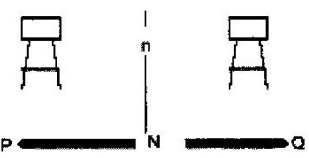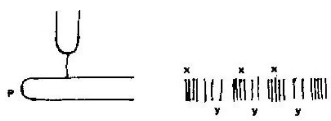Questions
- State the type of wave produced when a stretched string plucked
- When a sound wave travels from a dense to a less dense gas, its velocity changes. What wave property does this observation show?
- Standing waves are set up in a rope resulting in a series of nodes and antinodes.
In what state of motion is the rope at the nodes? - Two identical sources of sound S1 and S2 are emitting the same frequency. Explain with reasons, the observations that will be made by an observe listening to the sound emitted who was moving slowly along the lines, PQ and MN
- The table shows the frequency – squared f of the fundamental note produced by a stretched string for various tensions, T
T(N) 8 18 32 50 72 98 F2 (Hz) 14,500 32,500 57,500 90,000 129,500 176,500 - Plot a graph of f2 against the tension T.
- Determine the gradient of the graph and hence obtain an equation relating the frequency f and the tension T.
- A gun is fired and an echo heard at the same place 0.5s later. How far is the barrier, which reflected the sound from the gun? (Speed of sound 330m/s).
- State two ways by which frequency of a note produced by a given guitar wire may be increased.
- An observer watching a fireworks displays sees the light from an explosion and hears the sound 2 seconds later. How far was the explosion from the observer? (Speed of sound is air 340m/s)
-
- What is the differences between longitudinal and transverse waves?
- A mineworker stands between two vertical cliffs 400m from the nearest cliff. The cliffs are distance apart. Every time he strikes the rock once, he hears two echoes the first one comes after 2.5s while the second follows 2s later. From this information calculate:
- The speed of sound in air
- The value d
- A girl standing 600m away from a cliff bangs two pieces of wood together and hears an echo 3.5 seconds later. Determine the speed of sound in air at that place.
- What is an echo?
- Describe an experiment to show that sound cannot travel in a vacuum.
- The figure below shows air molecules in front of a hollow wooden box P set vibrating by a turning fork T of frequency 800Hz.
- What is the purpose of fixing the tuning fork on the box which is open on one end?
- Name the section labeled X and Y
- State and explain the nature of the waves shown
- Given that the speed of sound in air is 330ms-1. Calculate the wavelength of the waves.
- Sound is very faint in high altitudes than at sea level. Why?
- Distinguish between the following terms
- Intensity and loudness
- Frequency and pitch
- State two factors that affect the frequency of the note produced by a vibrating string
Answers
- Stationary waves
- Refraction of sound waves
- At rest
-
- Ups and down in the loudness of sound i.e. loud and soft sounds as crosses on nodal and antinodal lines. (Constructive and destructive interference)
- Constant loud sound since he is equidistant from both speakers and constructive interference takes place.
-
- Plot the graph of f2 (y-axis) against T.
- Determine its gradient (1800) from y= mx +c
f2 = (grad) T + C)
Obtain y intercept and substitute
f2=(grad) T +C)
Obtain y intercept and substitute
f2=2800 T + y-intercept
- 2x =330 x 0.5
x =82.5m - By making the wire tighter
Decreasing length of the wire - D= vt =340 x 2 = 680m
-
- Transverse-oscillations are perpendicular to direction of wave propagation.
Longitudinal – oscillation are parallel to direction of wave propagation.
Speed of sound
2.5 x s = 400 x 2
s = 320 m/s - 2(d − 400) = 2.5 + 2
320
d= 1,120m
- Transverse-oscillations are perpendicular to direction of wave propagation.
- Distance covered by sound
= 600 x 2 = 1200m
Speed= Distance = 1200 = 342.9 m/s
Time 3.5 - It is the reflected sound
- A source of sound i.e. an electric bell is suspended inside a bell jar. Using a suction pump air is pumped out of the jar when the lowest pressure is attained, one can see the hammer striking the bell but the ringing can no longer be heard. Sound cannot travel through a vacuum.
-
- Box act as amplifiers. The air inside the box is forced to vibrate as the box vibrates.
- X - Compressions
Y - Rarefaction - Longitudinal – The movement of air molecules is parallel to the direction of travel of the wave motion.
- Solution
Since V= fλ
Then λ = v/f
330
800
= 0.4125m
- – Air is less dense at the top of mountains or high altitude regions making transmission poor.
-
- Intensity and loudness- Intensity is the power carried by a wave and it depends on the distance from the source while loudness is the power of sound to reach the ear and it depends on amplitude of the source.
- Frequency and pitch – Frequency is the number of cycles made per second while pitch is how high on musical scale the note produced by an oscillator is.
- Solution
- Vibrating length
- Tension
Join our whatsapp group for latest updates
Tap Here to Download for 50/-
Get on WhatsApp for 50/-
Download Sound Questions and Answers - Physics Form 2 Topical Revision.
Tap Here to Download for 50/-
Get on WhatsApp for 50/-
Why download?
- ✔ To read offline at any time.
- ✔ To Print at your convenience
- ✔ Share Easily with Friends / Students



